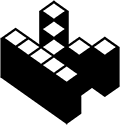
SATURDAY, FEB 27, 2016

Bliss Element Names
Bliss atoms for making Blissecules
Eric Lee, A-SOCIATED PRESS
TOPICS: CHARLES K. BLISS, SEMANTOGRAPHY, BLISSMBOLICS, LOGICAL LANGUAGE
TUCSON (A-P) — Start with the Bliss elements by noting what they are. First is the dot. A "period" in punctuation, the idea of dot is a dimensionless point made big enough to be noticeable. The only variation is to make the dot big enough to add a tail to make a "comma" character. Bliss elements include ASCII characters. The dot is one of a few Bliss elements shared with the ASCII characters for use as a basic symbol element. It differs in that no position is implied. If an ideograph for "human face" was pictographic, then adding a few dots could create an ideograph for "pimples" as a perhaps excessively pictographic word. Alternative to creating a new ideograph for "pimple" would be a compound word for "dots+on+face" with the understanding that "dots" are ones that develop and are not drawn on. To say "drawn on dots on face" would involve adding a Bliss word for "drawn." A new ideograph is not needed for every thought.
If an ideograph for "human face" was pictographic, then adding a few dots could create an ideograph for "pimples" as a perhaps excessively pictographic word. Alternative to creating a new ideograph for "pimple" would be a compound word for "dots+on+face" with the understanding that "dots" are ones that develop and are not drawn on. To say "drawn on dots on face" would involve adding a Bliss word for "drawn." A new ideograph is not needed for every thought.
Since the idea of "dots" is "dimensionless points," a dot is also the center of a circle. A large dot whose circumference alone is indicated by a curved line is the idea of "circle" and all dots equal distance from a dot would cover "sphere.". So "dot" and "central" go together. For a sound, use the central vowel sound, the schwa, the "uh" sound in "but" or the X-SAMPA [@] sound. So [@] is for "dot" or, depending on context, "central." Ideograms that contain the dot shape or the concept "central" could use the [@] sound. In typing Blisscript, a period may be used for @, so "but" [b@t] [b.t] are equivalent, and periods are easier to type.
. @
Lines
The next basic shape is the line. The concept of "line" in Bliss is represented by a squiggly mark with little hairs on top. No, just kidding. Bliss is the "logical" language, so it uses a vertical line (|) for "line" as the horizontal line is used for "ground" as in "surface of Earth" which all humans, until recently (maybe 5th century BCE) knew was flat and that all travel on it was "in a straight line." On the human scale of things walking an hour across a salt flat seems flat and straight, so Bliss is "logical" but not "pedantically logical." As a pedantic note: the horizontal line in Bliss is actually a curved line that exactly matches the equatorial curvature of the earth. It just looks flat, but don't believe it.

A horizontal line is a line of 0 slope, so call it "line 0." A perpendicular line to it would be vertical or a 90 degree line. Think of "vertical line" as "line 90." Two other lines are used to create Bliss ideograms. One is a line with a slope of 45 degrees. Call it "line 45." The other is "line 60" which is a line having a 60 degree slope. But wait, is the slope positive or negative? Since line 0 and line 90 have no slope or definable slope, line 45 and line 60 are not complete ideas. So borrowing from math we could think line-45, line+45, line-60, and line+60. Borrowing from geometry we could type them: line\45, line/45, line\60, and line|90 using the ASCII characters / [mijin] and \ [pijin] for up-positive slope and down-negative slope. Using / and \ is more pictographic and so more Bliss-like.
So there are six lines in Bliss that conceptually are line0, line/45, line\45, line/60, line\60, and line90. Typing the lines using a keyboard requires giving each a name, typing the name, and using a Bliss word processor to generate the shapes. If the names are also pronounceable, that is a plus.
To convert "line0 line/45 line\45 line/60 line\60 line|90" to Bliss we can use | for line to get to |0 |/45 |\45 |/60 |\60 |90. The | character is called [ipijin] and all the other characters have Bliss names, but |/45 would be [ipijin.mijin.din.en] which is too long for an elemental shape. The name starts with [ipijin] for "shifted P third-over key" and the first letter is i and shifted i is I, a vertical line in many fonts. So to simplify, the X-SAMPA sound [I] is for "line" (among other things as there are only 27 sounds in Bliss and so each can't be used for just one thing).
. [@]
| [I]
So 2 down, 30 more to go. Actually 0 1 2 3 are elemental Bliss shapes shared in common with ASCII characters. They are used to construct Bliss ideographs and not strung together to make ASCII text. The shared shapes are dot, 0123, / \ - ( ) and |, so only 32-11 = 21 uniquely Bliss non-ASCII elemental shapes. Actually two Bliss elements are just the upper part of the question mark character, in two different sizes, so while the shape isn't an ASCII character it is the main part of one with a dot added below to create a Bliss question mark symbol. So not that unique. Four Bliss elements are just parentheses characters in two sizes and two are parentheses characters rotated 90 degrees, so the six elemental parentheses are not so unique either.
Four elements of Bliss are the upper and lower parts of the full sized parentheses, so they are basically parts of parentheses. This leaves eight Bliss elements that are curves, four circle quadrant curved lines, in two sizes, so really four shapes in two sizes. That just leaves the two halves of the Bliss heart symbol to claim to be not a part of any ASCII character. The right half of the heart is the upper part of 2, so only left half is not part of any ASCII 7 bit character. So Bliss is different, but not all that different.
Back to the Lines
A horizontal line0 in Bliss means "surface of Earth" or, when on land, the "ground" we walk on. The other major meaning is for "sky" as "line between air and space" which is conceptually an important boundary line for air breathing land animals like us. To distinguish between the two, the "groundline" is written low and "skyline" is written high. The area between is the thin spread out film we live in and where most of what we write about takes place. So in Bliss (written  ), ground and sky lines are major and together make "the world" written in Bliss as
), ground and sky lines are major and together make "the world" written in Bliss as  .
.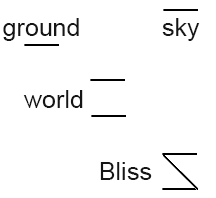
So World as Earth. "Earth" [@rT] starts with schwa sound, and as Prince Ea fans know, Ea is "Lord of Earth." And at it's center is a dot [@]. We humans think we are the center about which the universe spins, as is our Earth. Affectively, if not literally, this is true. So dot expanded is the surface of the planet we live on. To indicate an expanded dot, or sphere, let's add [r], middle sound in Earth to get [@r] the "urrr" sound in Earth. Those who speak Swahili and a few thousand other languages will see [@r] for "line0" as arbitrary, but the Babylonians would have been pleased. While it is possible to stress the [@r] in earth [@rT] is also possible to disreguard it, as [rT] and [@rT] sound alike. Write @r or .r, but say "rrrrr" for horizontal line0. Actually [.r] can often be reduced to [r] for all practical purposes.
. [@]
| [I]
_ [@r]
So four more to go and two share the same slope and two share the same angle. Slope is / [mijin] or \ [pijin], which boils down to / [m] or \ [p] for positive or negative slope. The [m] sound is for + slope, so English speakers can think "many" [mEni] and [p] sound is for - slope as p is close to the - key. This leaves line45 and line60, which boil down to line4 and line6. The angle is indicated by a consonant and a vowel is needed to indicate slope. Line0, no slope is [r] which can function like a vowel. Line90, verticle 90 degrees, is indicated by capital I. Line45 is in between and the middle vowel is shwa, [@]. Line90 gets the more common remaining vowel [e]. Elemental shapes require short names. So [m@ p@ me pe] are as short as can be since slope and angle define lines. Line0 and line90 have no slope so the angle vowel is enough information.

If you start with a dot and keep repeating it in a forward direction you get a horizontal line. If you say [@rrrrrrrrrrrrrrrrrrrrrr] and hold the [r] you are making a line of rrrrrrrrrrrrrrr's or dots so close together they form a line.
One small issue. CK Bliss did not use 30 degree lines to construct ideographs, or rather he did but did not mention that such lines existed in Bliss. 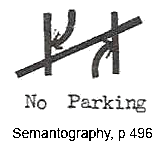 He designed several keyboard layouts for manual typewriters so Bliss could be typed. He did not include any 30 degree lines. Apart from trying to limit the number of keys needed, there is no logical reason to use 0 45 60 90 lines but not 30. CK Bliss did use them when drawing characters. Not often and he may have not caught himself using a non-existent line, but he did and future Bliss character designers could too. The less than < and greater than > characters are on a keyboard are made of 30 degree lines. In Bliss, the less than and greater than large characters are made of 45 degree lines instead as 30 degree lines as they are not officially used.
He designed several keyboard layouts for manual typewriters so Bliss could be typed. He did not include any 30 degree lines. Apart from trying to limit the number of keys needed, there is no logical reason to use 0 45 60 90 lines but not 30. CK Bliss did use them when drawing characters. Not often and he may have not caught himself using a non-existent line, but he did and future Bliss character designers could too. The less than < and greater than > characters are on a keyboard are made of 30 degree lines. In Bliss, the less than and greater than large characters are made of 45 degree lines instead as 30 degree lines as they are not officially used.
The similar looking indicator characters in Bliss do use 30 degree lines, so 30 degree lines are elemental lines and need names. There are no keyboard characters to adapt names from. A vowel is needed for a line30 slope and there is just one left, so [E] means 30 degree slope. The positive slope line+30 is [mE] and negative slope line-30 is [pE].
Curves
All that remains are curves. Curves are important elements in mathematics and the mathematical word is "curve" in Swahili (seriously), so "curve" is a start, but the sound is X-SAMPA [k], so think "kurve" which is Danish for "curve" and [k] is the first sound in many other languages (Afrikaans, Albanian, Armenian, Basque, Belarusian, Bosnian, Bulgarian..., and many more). So [k] and kurve go together.
A circle is not an elemental shape in Bliss as one can be made from sections which can then be used to make other ideographs. There could be many sections, but in Bliss there are only four, the four quadrants of a circle or the four parts, upper and lower, of a parenthesis which is a 120 degree section of a circle. The parenthesis section can be rotated 90 degrees to create upper and lower parentheses otherwise the same shape as right and left parentheses.
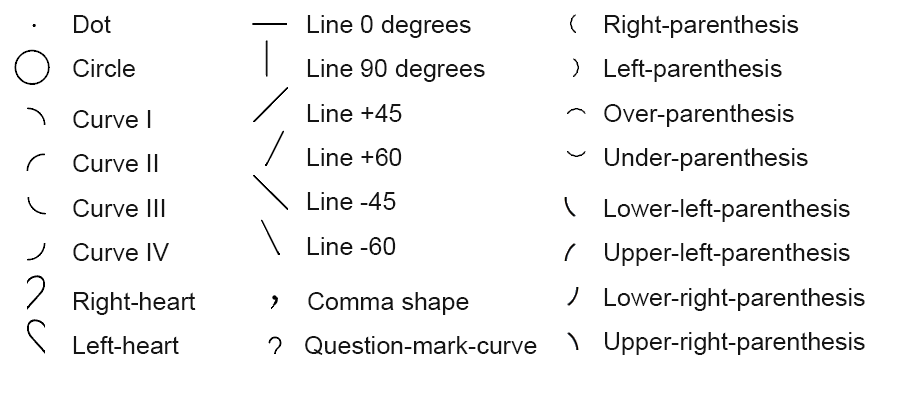
Per tradition, the quadrants are numbered counter-clockwise and named 1 2 3 4. Each curve is a quarter section or k1 k2 k3 k4. We can say in Bliss: [kian kibin kicin kidin]. This is short, but [in] is repetitive and so could be [kia kib kic kid], suggesting k1 k2 k3 k4, and could be a way of typing the names. Since the parts of a circle have names, and all curves together make a circle, Bliss for circle is [k] and the [ia ib ic id] refer to the parts of [k]. To say circle, add the filler vowel [e] and get [ke].
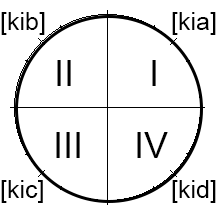
Parentheses
This leaves the parentheses shapes, ( [in] and ) [ijin]. One size is the same as ASCII at 1/2 size and so looks the same and can share the same name. One is left and one is right so if we had names for "left" and "right" the two could share one name. Bliss is read from left to right, so right > is forward and left < is back.
ASCII characters that point right and left are the less than and greater than ones, < [ibijin] and > [inijin], which in Bliss can mean pointing backwards and pointing forward.
Others are the brackets, [ [ijin] and ] [ojin], which open and close, point forward and back, to the future and past. So while [i] has been heavily used to name keyboard characters, most aren't going to spend much time talking about keyboard keys. The first sounds for [ and ] are [i] and [o], whose keys are side by side on keyboards, so to suggest right/left, before/after, open/closed, forward/back, and future/past, use [i o]
The parentheses are used in Bliss for future ( and past ) as ( opens to the future, to the right, and ) closes what is behind or to the left. The ASCII name for ( [iin] and ) [ijin] refers to the keys and the shape that is made when pressed. The Bliss ( is for future and ) for past as one opens up and one closes, one comes before and one after. The Bliss name for ( boils down to [i] and ) is [o].

If rotated 90 degrees, two unnamed shapes are created that can be thought of as "upper-over (" and "lower-bottom )" assuming a clockwise 90 degree rotation. So how shall we say "upper" and "lower" in Bliss? This is important as Bliss is not a string of characters one after the other. There is a vertical dimension heavy use is made of. The main use so far of "upper" and "lower" has been relative to the keyboard's upper and lower case. Lowercase is assumed and uppercase is "shift" plus a key. We use [i] for "shift" so "A" is [ia] and "B" is [ibi].
Little use has been used of the [a] or [u] vowel sounds, however, so [u], as every phonologist knows, is a high back rounded vowel, while [a] is merely a unrounded low front vowel, as low down as they get. So no reason to agonize, it's [u] for upper and [a] for lower. The over parenthesis opens downward and under parenthesis opens upward, so [u] indicates an upper/over shape opening downward, and [a] indicates a low/under/bottom shape opening upwards.
So 'upper (' becomes [uiin] and 'lower )' becomes [aijin]. But let's simplify to [u] and [a]. A [u] is for upper opening downward, and [a] means lower opening upwards.

The remaining parentheses curves are the upper and lower parts. The Lower left parenthesis, Upper left parenthesis, Lower right parenthesis, and Upper right parenthesis are the ideas in English. In Bliss we can say [ai ui ao uo].
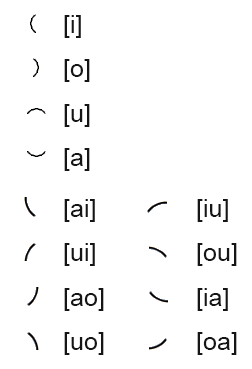
Combining two /2 half parentheses together makes a /1 parenthesis. To say [ai] with a consonant between, which is clearer, use [n] as the filler consonant. So say [ani] for [ai], [uni] for [ui], [ano] for [ao], and [uno] for [uo]. There are two full sized parentheses and their names are inevitably: ( [uniani] and ( [unoano].
In CK Bliss half-sized over and under parentheses are used but not full-sized ones. Elements that make up full-sized ones are on the left and named just because logic demands it. They could be used to construct ideograms or form full-sized over and under parentheses, inevitably called [inuonu] for over and [inaona] for under shapes. They are not currently used, but no reason they couldn't be. For experimental purposes, FoBliss will allow their use. 
The elemental curves can be combined in various ways. Some have meaning, some are unsed so far, but names follow shape and location.


The [n] in the above means join end to end. The [w] means join side by side or not end to end. There are many possible ways to combine elemental shapes to create sort of elemental shapes.
The next to last shape is the question mark curve which is only used to make question marks by adding a dot, but it is a needed elemental shape. The question mark is opposite the q key, q isn't used in Bliss, and happens to be the first letter of the name in some languages, so [q] sound can be for kuestion mark and those who can't say [q] can say [k] but write q. The [q] and other consonants cannot be spoken alone, so to say just the sound [q], add [e] for [qe] that sounds like ¿Qué? which in Spanish means what?, so ? is [qe] pronounced as in qué that rhymes with hay.
The remaining two curves are also special. They are the two sides of the international symbol for a human heart, and you gotta have heart. Two chamber good, four better, but all have two sides. Alone, the right heart curve means "ear" in Bliss. The left mirror image is unused in original Bliss. An irresistible ideogram would be both ears with the heart between to mean "listen to your heart."

The two halves still need names. and ( ) is [io], add a consonant before each that stands for heart or things, like humans, who need heart. The international Latin name of both family and genus for our species starts with "h" and that is good enough. So our left heart is [hi] and the right side is [ho] which also means "ear" in Bliss. The Bliss ideograph for heart is inevitably called [hiho]. Bliss is fun, and sometimes unintentionally funner.

The dot [@] is elemental and the only variation in use is comma, a dot made big enough that a little curved brush-like shape can be added below that goes to the left. One going to the right is also used in quote marks. The name for (left) comma in ASCII is [bijin]. The Bliss sign for "left" is left parenthesis shape [o], so normal left comma shape is [ob] and right comma shape is [ib]. So opening quote will be called [ibib] and close quote is [obob].

All 27 elemental shape names currently used are the Bliss "letters" of the alphabet:
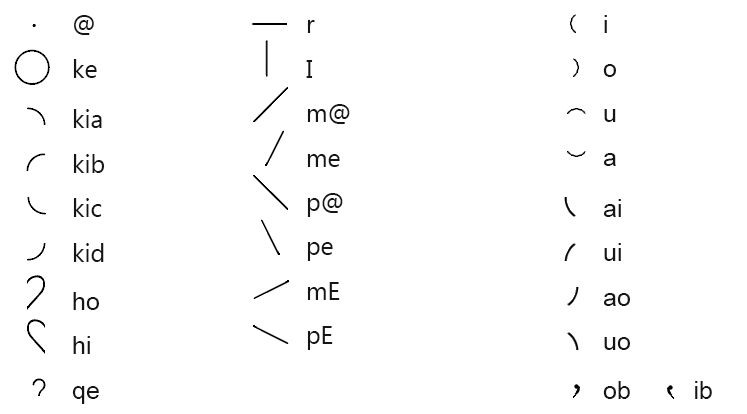
Elements of Bliss
There are actually more than 22 elemental shapes because two sizes of the "same shape" are different elements. The smallest line is 1/4 of a full sized line. If you repeat the 1/4 line 4 times you still have a straight line of the same shape, so all straight line lengths are the same shape. Curves as sections of different sized circles are different shapes in that they cannot just be added to different sized sections of curves and get a circle. To get a circle all sections have to be the same size, so size in curses matter.
There are three sizes in original Bliss with an extra small size for backward compatibility with BCI Bliss. If full size is 1 or 1/1, then half size is 1/2, third size is 1/3, and extra small is 1/4. But the 1 is repetitive, so /1, /2, /3, and /4 is good enough. No elemental curve section is full size, or /1, so largest section of a curve is a /2 curve with /4 curves used to make a half sized circle. To make a /4 circle, four /8 sections are used each of which are 1/8 full sized or /8 curves. To make a size /1 circle, use /2 curves, and for a /2 circle use /4 curves. The numbers suggest sounds for the different sizes, but there are some elemental sounds (phonemes) that haven't been used. It would be unreasonable (illogical) to not use them. The sizes are in order and the unused sounds in X-SAMPA when alphabetized are: g l s t v, so [g] is for full /1 size, [l] is /2, [s] is for /3 size, and [t] is for /4 size. The tiny little /8 curves needed to make /4 size circles are [v] size.
This leaves [xyz] as left overs for lesser use. An [x] means preceeding shape name is to be repeated without actually retyping. A [y] means join the following shape to the middle of the preceeding one. A [z] means abbreviation, usually to shorten a name of a common ideography mostly by adding to end, but can be added to start to truncate names that differ only by endings.
Sizes:

All Bliss symbols, other than the dot, are at least /3 size, so /4 [t] and /8 [v] is only used for BCI Bliss with the exception of the circle, parentheses, and sections of half curves for atoms, hair, pits, and claws. The [t] [v] and [z] sounds will have other uses and so will refer to /4 and /8 only in technical matters. Other sounds will be used, just not to reference Bliss elements [rtvwNS].
So [g] [l] [s] are needed and [l] and [s] used to name section curves. The /2 curves [l] needed to make a /1 circle need a vowel to go with [l] and [e] is available, so "size /2 curve section 1" is [lekia], [lekib], [lekic], [lekid]. Since /2 curve sections are the only ones commonly used, they are more simply called [kia], [kib], [kic], [kid].The smaller section curves starting with "size /4 curve section 1" and so on to make a /2 circle are: [tekia], [tekib], [tekic], [tekid]. A size /3 circle is currently not used, but could be as well as sections of it, and to allow it, curves of /6 size are needed to make /3 size curves. They are the [sekia], [sekib], [sekic], [sekid] quadrant curves. The "size /8 curve section 1" needed to make a /4 BCI circle are: [vekia], [vekib], [vekic], [vekid].
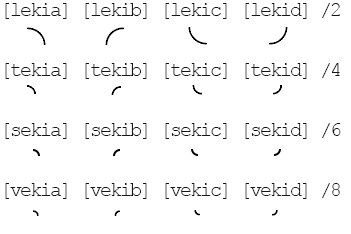
There are four sizes of complete parentheses. The full /1 size; half sized ones are /2 size, the indicator size is /3, and the tiny BCI size is /4. The BCI size was not used in original Bliss, but are used in FoBliss to indicate hair, claws, and the two /4 parentheses put together make a symbol for "pit" as in the seeds of certain fruit.  So the ideograph for "avocado" is the one for "pear" with a pit added. Indicating hair is useful, and an ideograph for quadrupedal animals with notable claws becomes a way to write "feline animal." Adding claws to the bird pictogram indicates "raptor." Otherwise the BCI /4 size is not used as /3 size is used (but not in BCI) and is more readable.
So the ideograph for "avocado" is the one for "pear" with a pit added. Indicating hair is useful, and an ideograph for quadrupedal animals with notable claws becomes a way to write "feline animal." Adding claws to the bird pictogram indicates "raptor." Otherwise the BCI /4 size is not used as /3 size is used (but not in BCI) and is more readable.
The question mark curve [q] sizes are /1, /2, /3, and /4, or [g l s t] so:

At this time the mirror image of [qe] is not an elemental shape like ) is of (. But logically it could be, and if (when) it is used its name will be [qei]. In Bliss speak the ? character with a dot could be called [qe@] but it is just call [qe] as in ¿Qué?.
 There are two shapes that don't fit and should be considered "elemental." The size of the X inside circles are different. The wheel is a [kel] size circle with an X size between [s] and [l] size, so the X is [sl] sized and the one in the [ke] circle is [lg] sized. The two X's could be considered elemental, but as they are used only in circles, the circleX shapes could be considered elemental.
There are two shapes that don't fit and should be considered "elemental." The size of the X inside circles are different. The wheel is a [kel] size circle with an X size between [s] and [l] size, so the X is [sl] sized and the one in the [ke] circle is [lg] sized. The two X's could be considered elemental, but as they are used only in circles, the circleX shapes could be considered elemental.
While the numbers 0123 are also Bliss elements, they are 1/3 sized when used as indicators and /2 when used within an ideograph. They have the same names as the ASCII characters. So that's all, the Bliss elements (letters) are named. The Bliss characters (words) and compound characters can now be named using names suggested by, but not dictated by, the 135 element names.





Possible Shapes
All Bliss elements can be combined to create existing characters. Elemental shapes may be considered to include simple shapes created by combining two similar elements. Those who may be tempted to design characters will want to consider all allowable shapes. To consider simple line shapes:
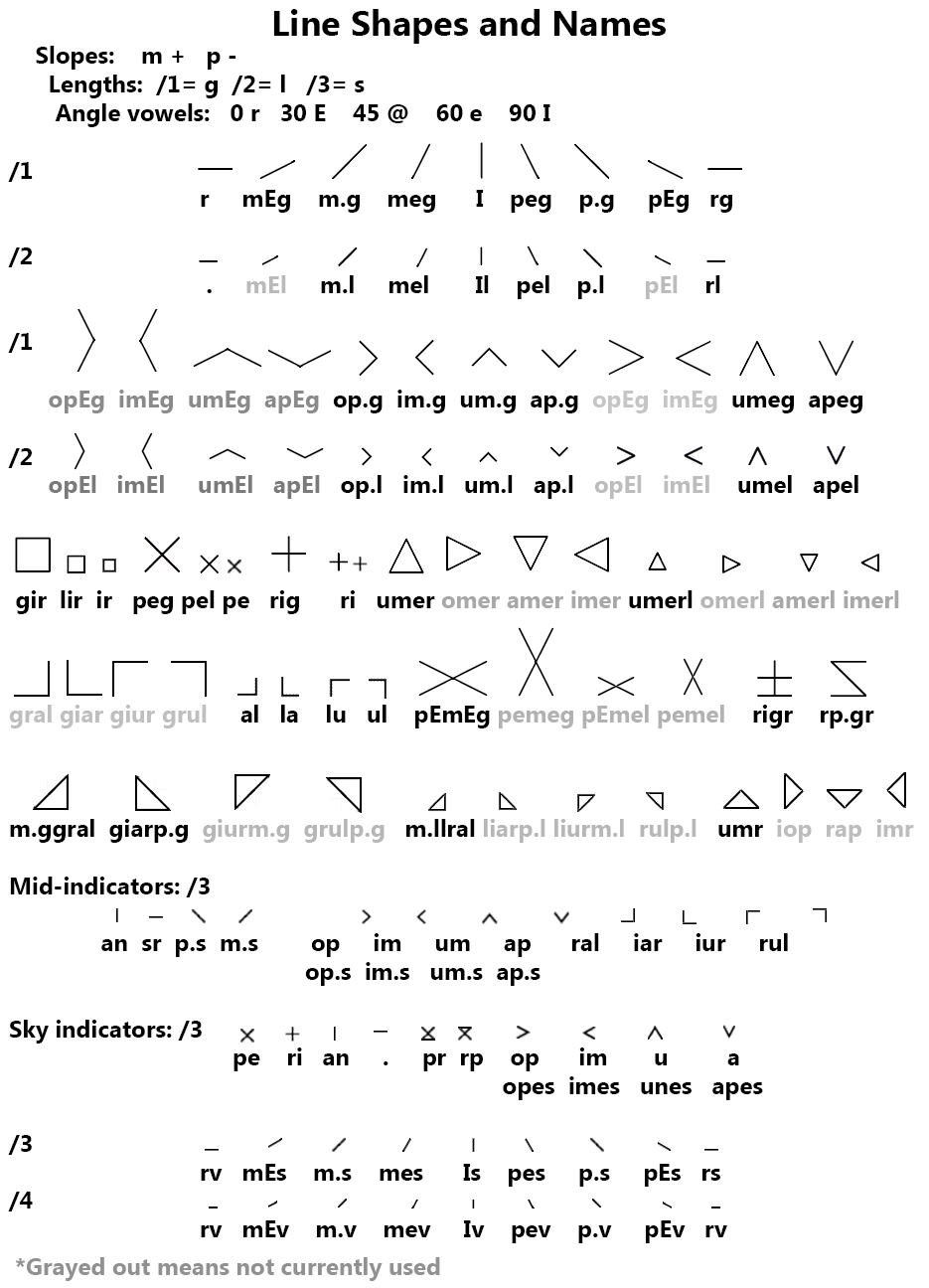
To consider curves:
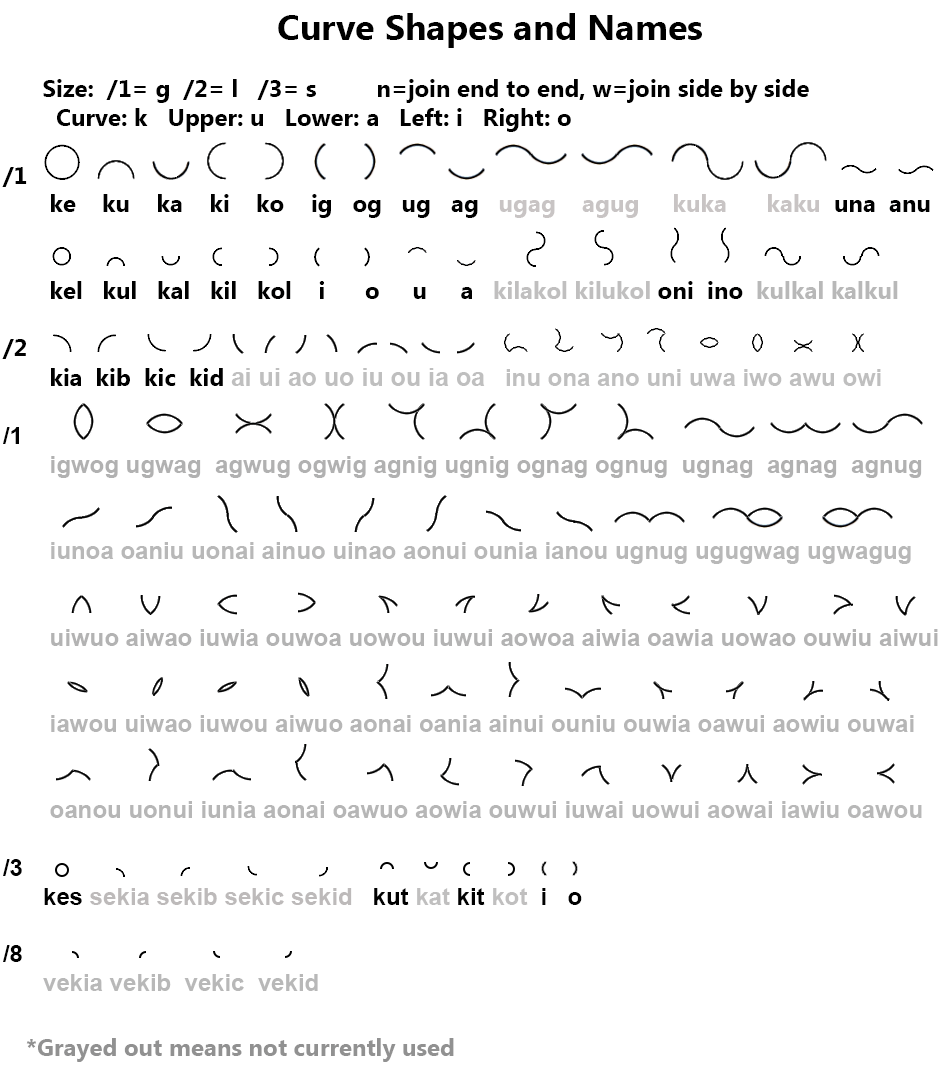
Not all possible combinations are shown in the above study in curves. One line or curve could connect to the middle or mid-point of another. Many possible shapes have not been used, but if they are, they have names. The /3 sized parentheses have the same name as the /2 sized as they are usually used in the sky area and the /2 in the mid-area. If /3 size is used in the mid-area, call them [is] and [os].

